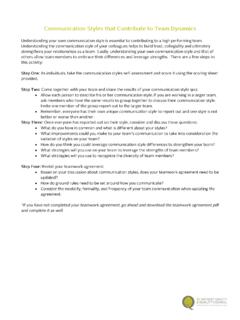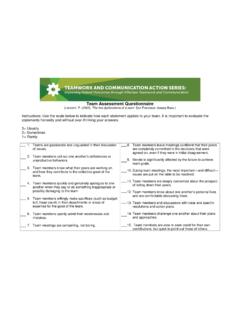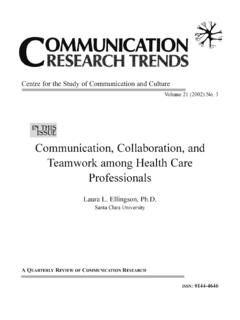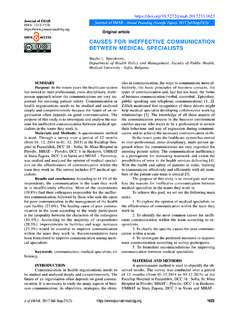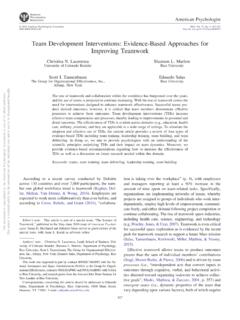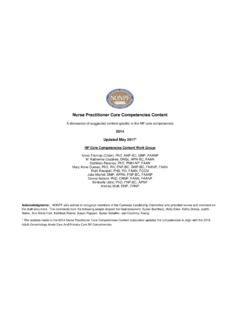Transcription of Interprofessional Communication in Health Care: An ...
1 ReviewInterprofessional Communication in healthcare: An integrative reviewCynthia Forondaa,*, Brent MacWilliamsb, Erin McArthurcaNursing, Johns Hopkins University, 525 N. Wolfe St., Baltimore, MD 21205, USAbUniversity of Wisconsin- Oshkosh, College of Nursing, 800 Algoma Blvd., Oshkosh, WI 54901, USAcUniversity of Wisconsin Oshkosh, 800 Algoma Blvd., Oshkosh, WI 54901, USAarticle infoArticle history:Received 23 April 2015 Received in revised form4 February 2016 Accepted 28 April 2016 Keywords: Interprofessional educationSimulationCommunicationCultural humilityPatient safetyabstractThe link between miscommunication and poor patient outcomes has been well documented. To un-derstand the current state of knowledge regarding Interprofessional Communication , an integrative re-view was performed.
2 The review suggested that nurses and physicians are trained differently and theyexhibit differences in Communication styles. The distinct frustrations that nurses and physiciansexpressed with each other were discussed. Egos, lack of confidence, lack of organization and structuralhierarchies hindered relationships and communications. Research suggested that training programs withthe use of standardized tools and simulation are effective in improving Interprofessional communicationskills. Recommendations include education beyond Communication techniques to address the broaderrelated constructs of patient safety, valuing diversity, team science, and cultural humility. Future di-rections in education are to add courses in patient safety to the curriculum, use handover tools that areinterprofessional in nature, practice in simulation hospitals for training, and use virtual simulation tounite the professions.
3 2016 Elsevier Ltd. All rights Background .. 362. Methods .. 373. Results .. Interprofessional Communication amongst healthcare professionals .. Interprofessional Communication amongst Health professions students .. Synthesis ..394. Discussion .. Limitations and gaps .. Recommendations .. Future directions ..395. Conclusion .. 40 References ..401. BackgroundThe link between miscommunication and poor patient out-comes has been well documented (The Joint Commission, 2015).Ineffective Communication in healthcare results in delayed treat-ment, misdiagnosis, medication errors, patient injury, or the effectiveness of Communication in healthcare is aglobal priority (ACSQHC, 2012;IPEC, 2011).Literature has highlighted the importance of interprofessionaltraining and educational reform (CAIPE, 2002; IPEC, 2011).
4 Schoolsof medicine, nursing, pharmacy, and other disciplines have takenon the challenge of increasing Interprofessional education*Corresponding McArthur).Contents lists available atScienceDirectNurse Education in Practicejournal 2016 Elsevier Ltd. All rights Education in Practice 19 (2016) 36e40experiences. Interprofessional workshops, online modules, andoffering Interprofessional simulations are expanding. However,patient safety training has not kept pace with advances in the sci-ence of patient safety (WHO, 2016), and best practices in commu-nication training in the educational institutions that prepare healthprofessionals are lagging the advent of the Interprofessional educational revolution,healthcare professionals are becoming increasingly comfortableopenly acknowledging Interprofessional differences such as di-versity in training, education, language and roles.
5 Despite thisprogress, the literature continues to reflect challenges between theprofessions in terms of Communication . Barriers to effectivecommunication have included lack of confidence, lack of experi-ence, complexity of healthcare, the distracting nature of healthcaresettings, and lack of structure and standardization (Boaro et al.,2010; Liaw et al., 2014; Nadzam, 2009; Pfaff et al., 2014; Riceet al., 2010). The purpose of this integrative review is to shedlight onto what is known regarding Interprofessional communi-cation in healthcare to identify recommendations for moving thescience MethodsWith the aim to obtain the current state of knowledge regardinginterprofessional Communication ,Whittemore and Knafl(2005) sintegrative review method was applied.
6 The literature searchincluded searching relevant databases (PubMed, Medline, CINAHL,and Google Scholar), mining reference lists of selected articles, andreviewing recommendations from experts. Databases weresearched using the termsinterprofessional Communication ,SBAR,nursing, andsimulation, in the context of both professional staffmembers and students. As we were seeking to understand anddescribe various approaches to Interprofessional Communication ina variety of contexts, inclusion criteria were deliberately non-restrictive. English language articles with publication dates span-ning 2005 and 2014 were included, allowing for the combination ofdiverse methodologies and greater breadth (Whittemore and Knafl,2005). Abstracts were read for relevance and 51 articles were readfor consideration.
7 A total of 28 articles were included in the ResultsThe review comprised of 18 research studies, six short papers,three literature reviews, and one theoretical framework paper. Thecategories emerged of Interprofessional Communication amongsthealthcare professionals and Interprofessional communicationamongst students. Differences in Communication styles as well asselect frustrations surfaced. The research suggested that interpro-fessional Communication skills can be significantly improved withtraining, including use of simulation and standardized communi-cation Interprofessional Communication amongst healthcareprofessionalsInterprofessional Communication happens in synchronous andasynchronous means. Synchronous genres refer to communicationshappening in real time such as a meeting, ward round, handoff, orimpromptu conversation (Conn et al.)
8 , 2009). Communications alsohappen asynchronously such as on white boards, through medi-cation orders, or written progress notes (Conn et al., 2009). Communication is not only verbal and written, it includes bodylanguage, attitude and tone (Nadzam, 2009).The literature suggests that physicians and nurses are traineddifferently in terms of Communication styles and these differenceslead to frustrations (Table 1). Nurses are trained to be highlydescriptive and physicians are trained to be succinct (Rodgers,2007). Members from different professions use their telling ofthe patient s story, framed in the narrative structure of theirown discipline, as a way to pass on information to their colleagues (Clark, 2014, p. 37). The embracing of true multivocality by ateam is the key to its achieving the kind of integrated communi-cation required for effective collaboration (Clark, 2014, p.
9 37).Physicians have noted frustration with nurse communications for disorganization of information, illogicalflow of content, lack ofpreparation to answer questions, inclusion of extraneous or irrel-evant information, and delay in getting to the point (Dixon et al.,2006, p. 377). Nurses indicated concerns with physician commu-nications due to perceived inattentiveness especially during nighthours, unwillingness to discuss goals of care, and feeling that a listof signs and symptoms had to be provided instead of just statingwhat the nurse thought the clinical problem was (Dixon et al.,2006, p. 377).Research in the intensive care unit (ICU) has revealed challengesresulting from Interprofessional Communication . In a studyperformed with 272 nurses from 17 ICU s,Gurses and Carayon(2007)found nurse-physician Communication was identified as aperformance obstacle by ICU nurses.
10 Twenty one of participantsnoted delays in seeing new medical orders and 18% of participantsfelt there was inadequate information provided from the context of home Health ,Markley and Winbery (2008)stated that it only takes a few seconds of listening to a clinician sreport of a patient s condition for the physician to determine ifhe or she trusts their opinion. They purported that nurses can earnthe trust of physicians by skillfully communicating the facts, mak-ing targeted recommendations with confidence (Markleyand Winbery, 2008).Perron et al. (2014)performed a Delphistudy to identify the themes and skills most needed to be taughtduring Interprofessional programs. The top theme obtained washealthcare provider Communication with the patient and et al.
